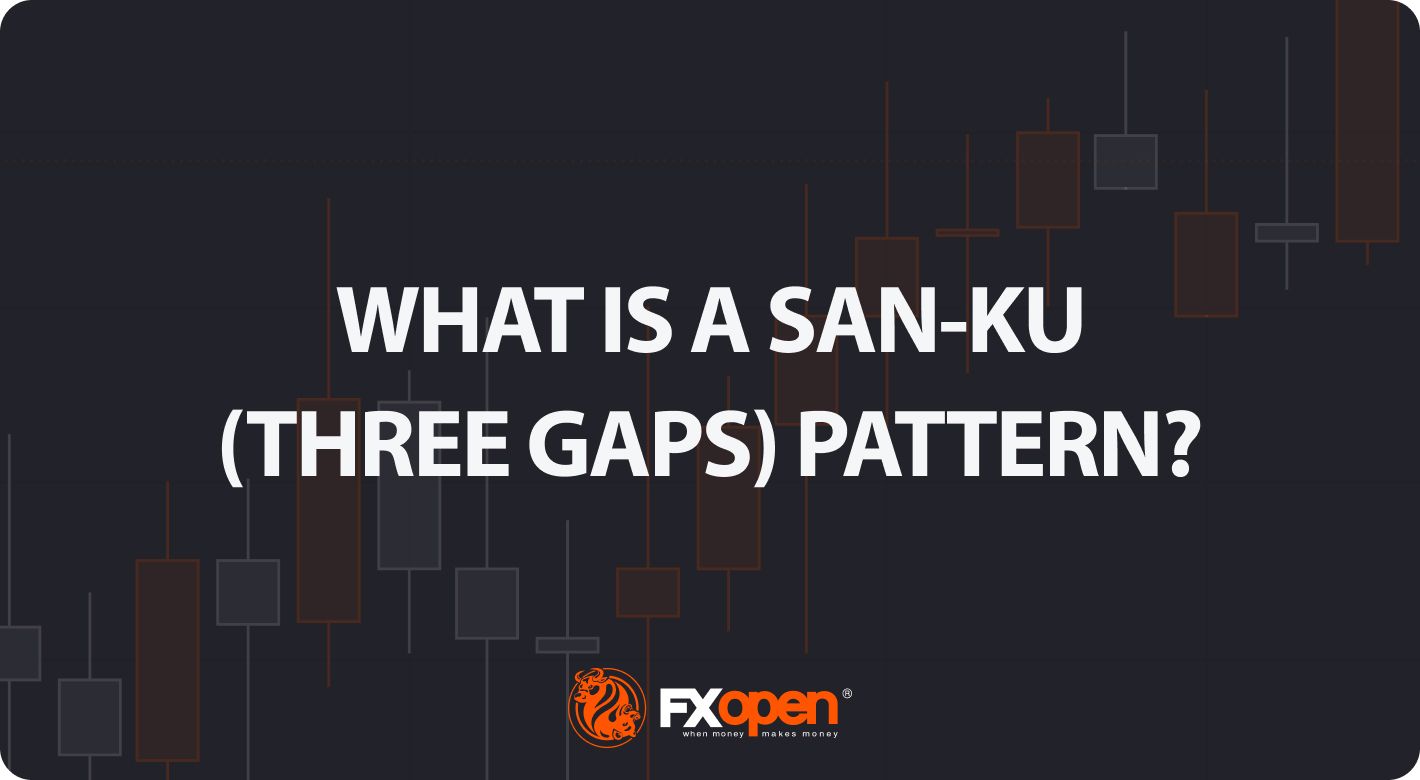FXOpen

The intriguing and captivating San-Ku, or Three Gaps, pattern draws the curiosity of traders within financial markets. Its distinctive form and strategic placement on price charts make it a compelling subject for observation and analysis. This article aims to explore the intricacies of the San-Ku pattern, highlighting its importance and providing insights into how traders can incorporate it into their trading strategies.
What Is a Three Gaps (San-Ku) Pattern?
The San-Ku, or Three Gaps, pattern is a distinctive technical analysis formation characterised by three consecutive upward or downward price gaps. This pattern often signifies a significant shift in market sentiment and a potential trend reversal. Traders keen on spotting trend changes find the formation intriguing due to its clear visual representation on price charts.
Identifying the setup involves recognising three successive gaps in the price movement, whether upward or downward. These gaps indicate abrupt shifts in market sentiment and are typically accompanied by increased trading volume. The pattern manifests itself as a series of price jumps, creating a visual sequence that stands out on a chart.

How to Trade the San-Ku Three Spaces
Traders may enter a position based on the assumption of a trend reversal. In a bullish formation, you may consider entering a long position after the third gap down, signalling a potential bullish trend. Conversely, in a bearish pattern, you may initiate a short position after the third gap, anticipating a bearish trend.
To establish a take-profit level, you may assess the historical price behaviour around the formation. Look for significant support or resistance levels, trendlines, or Fibonacci retracement levels to gauge potential reversal points. Adjust your take profit accordingly, aiming for a favourable risk-to-reward ratio.
Implementing a well-placed stop loss is crucial to manage risk. You may position the stop loss below the setup in an upward pattern and above the setup in a downward pattern. This may help mitigate potential losses if the market does not follow the expected reversal.
Live Market Example
Let's explore a live market example on the TickTrader platform by FXOpen to illustrate trading with the Three Gaps pattern. In this scenario, we observe the setup, indicating a potential reversal of a bullish trend.
A trader could enter a short position after the third candle closes, anticipating a bearish trend, setting the take-profit level at a support level based on historical price action. As the trader used a daily chart, the stop-loss level was supposed to be calculated based on the risk/reward ratio and placed above the Triple Gap.
Final Thoughts
Although San-Ku is an effective pattern, it can’t guarantee a trend reversal. As with any technical analysis tool, it's crucial to consider the broader market context and use risk management strategies to improve overall trading performance. Remember, no pattern guarantees success, and thorough analysis remains paramount in making informed trading decisions. If you want to test different trading approaches, you can open an FXOpen account.
FAQ
Is the Three Gaps Setup Suitable for All Types of Assets?
This formation can be applied to various financial instruments, including stocks, currencies, commodities, and indices. However, it's essential to adapt your strategy to the specific characteristics of the asset you are trading and consider factors like liquidity and market behaviour.
How Can Traders Stay Updated on Potential Three Gaps Formations?
Traders can use charting platforms, technical analysis tools, and market scanners to stay informed about potential Three Gaps formations. Setting up alerts for specific price movements and gap occurrences can also help traders promptly identify opportunities as they arise.
Are There Any Common Mistakes Traders Make When Interpreting the Three Gaps?
One common mistake is relying solely on the setup without considering broader market conditions. Traders shouldn’t neglect the overall trend, market sentiment, and potential catalysts that could influence price movements. Additionally, thorough backtesting and analysis are crucial to validating the reliability of the pattern in different market conditions.
Can I Find the Three Gaps Pattern on the NVDA Candlestick Chart?
You can find this pattern in different markets, but remember that its effectiveness will depend on the timeframe you use and the strategy you implement. Keep in mind that the presence of the Three Gaps Pattern on a stock's chart does not guarantee future price movements. It's essential to conduct thorough technical and fundamental analysis and practise risk management when making trading decisions.
This article represents the opinion of the Companies operating under the FXOpen brand only. It is not to be construed as an offer, solicitation, or recommendation with respect to products and services provided by the Companies operating under the FXOpen brand, nor is it to be considered financial advice.
Stay ahead of the market!
Subscribe now to our mailing list and receive the latest market news and insights delivered directly to your inbox.








